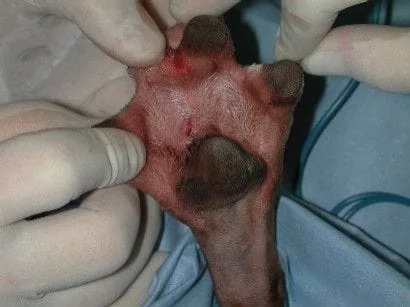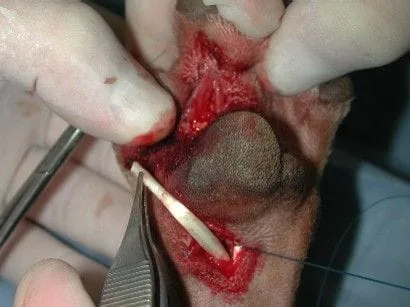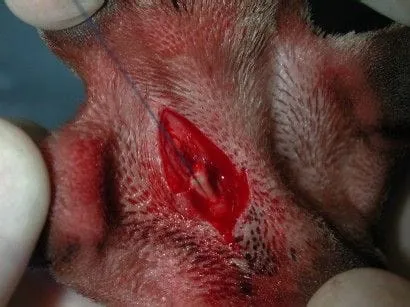Key Points
The digits (toes) have three tendons
A digit that has rupture of the digital flexor tendons will stick up more than normal
Prognosis is good following surgery
Anatomy
- The digits (toes) have three tendons
- Two tendons are located on the bottom of the bones (deep digital flexor and superficial flexor tendons) and these serve to flex the toes
- The flexor tendons are more important than the extensors
- Another tendon goes to each toe on the top side of the digit and it extends the digits

Causes of digital tendon rupture
- Laceration from a sharp object such as sharp metal, broken glass, sharp instruments (knives, scissors etc)
- In some animals the signs of a lacerated tendon (other than a skin wound) is not obvious at the time of initial examination, as the tendon has not been completely severed; if this is not corrected with surgery, the tendon may tear completely in the future resulting in obvious clinical signs of a “sprung toe”
- Excessive hyperextension of the digit resulting in a tear of the digital flexors
Diagnosis
- The diagnosis of tendon rupture is based on physical examination
- A digit that has rupture of the digital flexor tendons will stick up more than normal; the result is that the pad does not assume a weight-bearing position, which the result may be sores on the digit because the pad is not contacting the ground when walking and running
- Take note of the middle digit that has torn superficial and deep digital flexor tendons; the toe nail rides high in this toe

- Take note of the small laceration (dog stepped on broken glass) just in front of the large metatarsal pad

Treatment options
- No treatment is an option, but for the best function of the toe, surgery should be done
- Surgery involves making an incision over the area to expose the ruptured tendons
- In the photo below, an incision behind the large metatarsal pad was made as the tendon retracted beneath the metatarsal pad

- In the photo below a suture has been placed in the lacerated tendon which will be reattached back to the digit

- The ruptured tendon is sutured together with a locking-loop suture pattern
- In order to keep the toe in flexion, thereby taking pressure off of the repaired tendon, a mattress suture is placed in the digital pad to the metatarsal (hind limb) or metacarpal (front limb) pad; this suture is removed after about 4 weeks
- After surgery a cast is applied to support the tendon repair for 2 months
- If the initial surgery is unsuccessful a podoplasty can be performed which involves removing the skin between the large metacarpal or metatarsal pad and the digital pads and suturing pads together
Healing
- Generally healing of a tendon takes about 2 months
Postop care
- Protect the cast from getting soiled or wet – a plastic bag should be put on the foot when going outside
- Check the toes to make sure that there is no associated swelling


